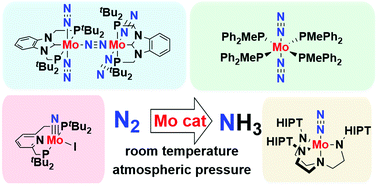Catalytic conversion of nitrogen molecule into ammonia using molybdenum complexes under ambient reaction conditions
Abstract
Nitrogen fixation using homogeneous transition metal complexes under mild reaction conditions is a challenging topic in the field of chemistry. Several successful examples of the catalytic conversion of nitrogen molecule into ammonia using various transition metal complexes in the presence of reductants and proton sources have been reported so far, together with detailed investigations on the reaction mechanism. Among these, only molybdenum complexes have been shown to serve as effective catalysts under ambient reaction conditions, in stark contrast with other transition metal-catalysed reactions that proceed at low reaction temperature such as −78 °C. In this feature article, we classify the molybdenum-catalysed reactions into four types: reactions via the Schrock cycle, reactions via dinuclear reaction systems, reactions via direct cleavage of the nitrogen–nitrogen triple bond of dinitrogen, and reactions via the Chatt-type cycle. We describe these catalytic systems focusing on the catalytic activity and mechanistic investigations. We hope that the present feature article provides useful information to develop more efficient nitrogen fixation systems under mild reaction conditions.

- This article is part of the themed collection: Chemical Communications HOT articles


 Please wait while we load your content...
Please wait while we load your content...
